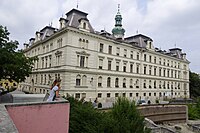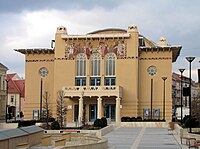Sopron
Sopron
Ödenburg | ||
|---|---|---|
| Sopron Megyei Jogú Város | ||
      | ||
|
MP Attila Barcza (Fidesz) | | |
| Website | www | |
Sopron (Hungarian pronunciation: [ˈʃopron]; German: Ödenburg, German pronunciation: [ˈøːdn̩ˌbʊʁk] ⓘ) is a city in Hungary on the Austrian border, near Lake Neusiedl/Lake Fertő.
History
Ancient times-13th century

When the area that is today Western Hungary was a province of the Roman Empire, a city called Scarbantia stood here. Its forum was located where the main square of Sopron can be found today.
During the
In 1273, King
16th-19th centuries
During the Ottoman occupation of Hungary, the Ottoman Turks ravaged the city in 1529, but did not occupy it. Many Hungarians fled from the occupied areas to Sopron, and the city's importance grew.
While the Ottomans occupied most of Central Europe, the region north of Lake Balaton remained in the
In 1676, Sopron was destroyed by a fire. The modern city was born over the next few decades, when
The town was the seat of the Ödenburg comitat near 1850.
20th century to present

Following the breakup of the
Sopron suffered greatly during World War II and was bombed several times. The Soviet Red Army captured the city on April 1, 1945.
The city of Sopron and the village of Sopronbánfalva began to stretch towards each other at the beginning of the 20th century, they unified in 1950 and since the areas have merged.[8][1] Sopron and the village of Balf unified in 1985.[1]
On August 19, 1989, Sopron was the site of the Pan-European Picnic, a protest on the border between Austria and Hungary, which was used by over 600 citizens of East Germany to escape to the West. As the first successful crossing of the border, it helped pave the way for the mass flight of East German citizens that led to the fall of the Berlin Wall on November 9, 1989.
During the Socialist era, the government tried to turn Sopron into an industrial city, but much of the medieval town center remains, allowing the city to remain an attractive site for tourists.
Today, Sopron's economy immensely benefits from the European Union. Having been a city close to nowhere, that is, to the Iron Curtain, Sopron now has re-established full trade relations to nearby Austria. Furthermore, after being suppressed during the Cold War, Sopron's German-speaking culture and heritage are now recognized again. As a consequence, many of the city's street-and traffic-signs are written in both Hungarian and German making it an officially bilingual city due to its proximity to the Austrian frontier. Visitors admire the large number of buildings in this city that reflect medieval architecture—rare in war-torn Hungary. Situated close to the Austrian border, Sopron receives many visitors from Vienna (70 kilometres (43 miles) away), and from Bratislava, Slovakia (77 km (48 mi) away), as well as from the United States, Great Britain, The Netherlands, Japan, and Scandinavia, who visit to take advantage of the excellent low-cost dental services offered: Sopron boasts so many dental clinics—more than 300—that the city is known as the "dental capital of the world."[9][10]
Wine production
Sopron is a significant
The group of ethnic German wine growers in the Sopron area in the Habsburg Monarchy were the so-called Ponzichter.
Demographics

| Year | Pop. | ±% |
|---|---|---|
| 1870 | 23,102 | — |
| 1880 | 25,513 | +10.4% |
| 1890 | 29,788 | +16.8% |
| 1900 | 35,703 | +19.9% |
| 1910 | 36,721 | +2.9% |
| 1920 | 38,243 | +4.1% |
| 1930 | 39,436 | +3.1% |
| 1941 | 46,120 | +16.9% |
| 1949 | 35,617 | −22.8% |
| 1960 | 41,110 | +15.4% |
| 1970 | 47,111 | +14.6% |
| 1980 | 53,945 | +14.5% |
| 1990 | 55,083 | +2.1% |
| 2001 | 56,175 | +2.0% |
| 2011 | 60,548 | +7.8% |
| 2022 | 60,090 | −0.8% |
In 1910, Sopron had 33,931 inhabitants (51%
Architecture
The architecture of the old section of town reflects its long history; walls and foundations from the
There is an old
On Daloshegy, there is a 165-metre tall FM-/TV-broadcasting tower, nicknamed "Rakéta" (Hungarian for rocket).
Places of interest
- City centre
- Firewatch Tower
- Walls with Roman origin
- Széchenyi Square and Flag of Loyalty
- Kecske Church
- Esterházy Palace (baroque)
- Eggenberg House
- City Hall (eclectic, 1895)
- Storno House (renaissance)
- Fabricius House
- "Two Moors" House (18th century baroque)
- Chemist's Museum (15th–16th century. The house was pronounced the first national monument in Hungary by Louis II of Hungary in 1525.)
- Lábasház (16th–17th century)
- Gambrinus House (Old city hall)
- Taródi Castle (István Taródi built the castle by himself. He started the building operations in 1945, when he was 20.)
Amusement
- Cartoon Forum (From Tuesday 14 to Friday 17 September 2010)
- Spring Festival of Sopron (Soproni Tavaszi Fesztivál)
- Festal Weeks of Sopron (Soproni Ünnepi Hetek)
- VOLT festival
- Civitas Pinceszínház (Civitas Basement Theater)
- Liszt Ferenc Művelődési Központ (Franz Liszt Conference and Cultural Centre )
Politics
The current mayor of Sopron is Ciprián Farkas (Fidesz-KDNP).
The local Municipal Assembly, elected at the 2019 local government elections, is made up of 18 members (1 Mayor, 12 Individual constituencies MEPs and 5 Compensation List MEPs) divided into this political parties and alliances:[16]
| Party | Seats | Current Municipal Assembly | |||||||||||||
|---|---|---|---|---|---|---|---|---|---|---|---|---|---|---|---|
| Fidesz-KDNP | 13 | M | |||||||||||||
| Opposition coalition[a] | 4 | ||||||||||||||
Dialogue
|
1 | ||||||||||||||
Gallery
-
Goat Church and Holy Trinity Column
-
Saint Michael's Church
-
County Hall of Győr-Moson-Sopron County
-
Fire Tower
-
Town Hall
-
Petőfi Theater
-
Esterházy Palace in the Temple Street
-
Orsolya Square and the Mary Fountain
-
New Street
-
Gothic house in the New Street
-
Előkapu Square
-
House, Kolostor Street 13.
-
Ikva Bridge
-
Statue of István Széchenyi
-
Bilingual sign
Sports
The women's basketball team
Notable residents
- Rogerius of Apulia(1205-1266), medieval chronicler
- Eggenberg
- Dániel Berzsenyi (1776-1836), poet
- Ludwig von Benedek (1804-1881), Austrian general
- Franz Liszt (1811-1886), composer
- Franz von Suppé (1819-1895), composer
- Julius Lenck (1845 - 1901), Hungarian-German brewer, wholesaler and the founder of the Sopron Brewery (Soproni Sörgyár).
- Gyula Fényi (1845-1927), astronomer
- László Rátz (1863-1930), mathematics teacher
- Kálmán Kánya (1869-1945), politician, diplomat, Foreign Minister
- Franz Lehár (1870-1948), composer
- Béla Bartók (1881-1945), composer
- Charles I of Austria (1887-1922), last king of Hungary
- Georg Trakl (1887-1914), poet
- Mátyás Rákosi (1892-1971), politician, communist leader
- Israeli declaration of independence
- Margaret Mahler (1897-1985), psychoanalyst
- Sandor Gallus (1907-1996), archaeologist
- Géza Ankerl (born 1933), Professor of MIT (Massachusetts Institute of Technology), sociologist
- Alexander Gallus (born 1940), medical researcher
- József Szájer (born 1961), politician
- István Hiller (born 1964), politician, Minister of Culture
- Mihály Tóth(born 1974), football player
- Vilmos Radasics (born 1983), BMX rider
- Tímea Babos (born 1993), tennis player
- Botond Balogh (born 2002), football player
- Balogh de Mankó Bük, Hungarian nobility
- József Rokop, freedom fighter
- Terezia Mora, writer
Twin towns – sister cities
 Bad Wimpfen, Germany
Bad Wimpfen, Germany Banská Štiavnica, Slovakia
Banská Štiavnica, Slovakia Bolzano, Italy
Bolzano, Italy Eilat, Israel
Eilat, Israel Eisenstadt, Austria
Eisenstadt, Austria Kazuno, Japan
Kazuno, Japan Kempten, Germany
Kempten, Germany Mediaș, Romania
Mediaș, Romania Rorschach, Switzerland
Rorschach, Switzerland Seinäjoki, Finland
Seinäjoki, Finland Sparta, Greece
Sparta, Greece
See also
- Daughters of the Divine Redeemer
- Jewish history of Sopron
- Lake Neusiedl
References
- ^ a b c "Sopron". Hungarian Central Statistical Office (KSH).
- ^ Eurostat, 2016
- ^ KSH - Sopron, 2011
- ^ KSH - Sopron, 2011
- ^ Dictionnaire universel de M.N. BOUILLET, Paris, 1852 (in French).
- ^ Handbook of Austria and Lombardy-Venetia Cancellations on the Postage Stamp Issues 1850-1864, by Edwin MUELLER, 1961.
- ^ Beigbeder, Yves (1994), International Monitoring of Plebiscites, Referenda and National Elections, Springer Publishing, p. 81
- ^ Éva, Sági (2013). "Sopron peremkerületeinek változása néhány példán keresztül" [Changes in the Peripheral Districts of Sopron Through Some Examples]. Soproni Szemle – A Soproni Városszépítő Egyesület helytörténeti folyóirata (The local history magazine of the Sopron City Beautification Association) (in Hungarian). 67 (2): 163–175.
- ^ Surmacz, Jon. "Sopron Hungarian cap city". www.ripso.com. Archived from the original on 2016-01-26. Retrieved 2009-06-19.
- ^ Beth, Mary. "The inciDENTAL tourist". USA Today.
- ^ "Wine Regions Sopron". www.winetime.hu. Archived from the original on 2016-04-10. Retrieved 2009-06-19.
- ^ "1910 census (English)". Archived from the original on 2008-03-29. Retrieved 2008-08-27.
- ^ 2001 census - Nationalities (in Hungarian)
- ^ 2001 census - Religions (in Hungarian)
- ^ Historical population of Győr-Moson-Sopron (Hungarian Central Statistical Office) (in Hungarian)
- ^ "Városi közgyűlés tagjai 2019-2024 - Sopron (Győr-Moson-Sopron megye)". valasztas.hu. Retrieved 2019-11-24.
- ^ "Testvérvárosaink". sopron.hu (in Hungarian). Sopron. Retrieved 2020-11-10.
- Notes
- Mindenki Magyarországa.
External links
- Official website in Hungarian, English and German
- University of West Hungary (University of Sopron) (in English and Hungarian)
- ImageTownsIndex - Virtual Tour of Sopron (in Hungarian)
- Aerial photography: Sopron
- Accommodation in Sopron
- (in English) Sopron at funiq.hu


















